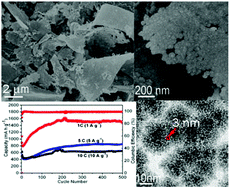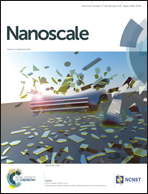One-step thermolysis synthesis of two-dimensional ultrafine Fe3O4 particles/carbon nanonetworks for high-performance lithium-ion batteries†
Abstract
To tackle the issue of inferior cycle stability and rate capability for Fe3O4 anode materials in lithium ion batteries, ultrafine Fe3O4 nanocrystals uniformly encapsulated in two-dimensional (2D) carbon nanonetworks have been fabricated through thermolysis of a simple, low-cost iron(III) acetylacetonate without any extra processes. Moreover, compared to the reported Fe3O4/carbon composites, the particle size of Fe3O4 is controllable and held down to ∼3 nm. Benefitting from the synergistic effects of the excellent electroconductive carbon nanonetworks and uniform distribution of ultrafine Fe3O4 particles, the prepared 2D Fe3O4/carbon nanonetwork anode exhibits high reversible capacity, excellent rate capability and superior cyclability. A high capacity of 1534 mA h g−1 is achieved at a 1 C rate and is maintained without decay up to 500 cycles (1 C = 1 A g−1). Even at the high current density of 5 C and 10 C, the 2D Fe3O4/carbon nanonetworks maintain a reversible capacity of 845 and 647 mA h g−1 after 500 discharge/charge cycles, respectively. In comparison with other reported Fe3O4-based anodes, the 2D Fe3O4/carbon nanonetwork electrode is one of the most attractive of those in energy storage applications.


 Please wait while we load your content...
Please wait while we load your content...